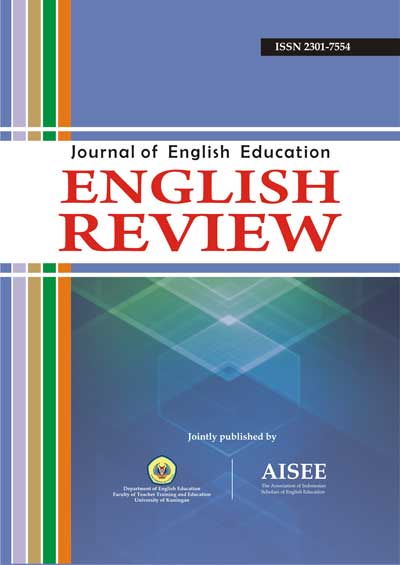INCORPORATING A COGNITIVE LINGUISTICS APPROACH TO THE TEACHING OF A SELECTION OF FIGURATIVE IDIOMS IN EFL CONTEXT
Abstract
Abstract: Prodromou (2003: 43) states that “the way for a student of English to become more fluent in the language is not only to have a good command of grammar and vocabulary but also a good command of the ‘idiom principle’ and there is “the need for idiomatic competence is precisely what linguists propose for the non-native speakerâ€. In addition, research shows that idioms are among the biggest challenge for EFL/ESL learners. The aim of this paper is to shed some light on ways to deal with a selection of figurative idioms by employing a CL perspective and to suggest some pedagogical implications. The paper attempts to examine a small number of Vietnamese EFL learners in the use of a non CL and a CL activity to evaluate its effectiveness and learning gains. The results could be used to further explore the use of CL to the teaching of idioms.
Key words: cognitive linguistics, figurative idioms, corporaÂ
References
Boers, F. (2001). Remembering figurative idioms by hypothesising about their origin. Prospect, 16 (3), 35-43.
Boers, F., Eyckmans, J., & Stengers, H. (2007). Presenting figurative idioms with a touch of etymology: More than mere mnemonics? Language Teaching Research, 11(1), 43-62.
Grant, L. E. (2007). In a manner of speaking: Assessing frequent spoken figurative idioms to assist ESL/EFL teachers. System, 35, 169-181.
Irujo, S. (1986). Don’t put your leg in your mouth: Transfer in the acquisition of idioms in a second language. TESOL Quarterly, 20(2), 287-304.
Liu, D. (2003). The most frequently used spoken American English Idioms: A corpus analysis and its implications. TESOL Quarterly, 37(4), 671-700.
MacArthur, F., & Boers, F. (in press). Using visuals to illustrate the source domains of idioms: Can they help learners appreciate usage restrictions too? In. C. Juchem-Grundmann., & S. Niemeier (Eds.), Knowing is seeing: Metaphor and language pedagogy (1-39). Berlin: Mouton de Gruyter.
Prodromou, L. (2003). Idiomaticity and the non-native speaker. English Today, 19(2), 42-48.
Simpson, R., & Mendis, D. (2003). A corpus-based study of idioms in academic speech. TESOL Quarterly, 37(3), 419-441.
Szczepaniak, R., & Lew, R. (2011). The role of imagery in dictionaries of idioms. Applied Linguistics, 32(3), 323-347.
Tomlinson, B., & Dat, B. (2004). The contributions of Vietnamese learners of English to ELT methodology. Language Teaching Research, 8(2), 199-222.
Yorio, C. A. (1989). Idiomaticity as an indicator of second language proficiency. In Hyltenstam, K., & Obler, L. K. (Eds), Bilingualism across the lifespan: Aspects of acquisition, maturity, and loss (pp. 55-72). Cambridge, UK: Cambridge University Press.
All articles published in English Review: Journal of English Education (ERJEE) are licensed under the Creative Commons Attribution 4.0 International License (CC BY 4.0).
Copyright Ownership
Authors retain the copyright of their articles and grant ERJEE the right of first publication. The journal is granted a non-exclusive license to publish, reproduce, and distribute the article in any format, medium, or platform, provided that proper credit is given to the original authors.
License Terms – CC BY 4.0
Under the Creative Commons Attribution 4.0 International License, others are free to:
- Share — copy and redistribute the material in any medium or format
- Adapt — remix, transform, and build upon the material for any purpose, even commercially
As long as they:
- Provide appropriate credit to the original author(s) and source
- Provide a link to the license (https://creativecommons.org/licenses/by/4.0/)
- Indicate if any changes were made
There are no restrictions on the reuse, reproduction, or adaptation of published articles as long as attribution is properly given.
Author Warranties
By submitting a manuscript to ERJEE, authors confirm that:
- The work is original and does not infringe any existing copyright.
- The manuscript has not been previously published and is not under consideration elsewhere.
- All sources and references are appropriately acknowledged.
- Necessary permissions have been obtained for any copyrighted materials used.









